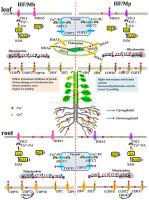当前位置:
X-MOL 学术
›
Environ. Pollut.
›
论文详情
Our official English website, www.x-mol.net, welcomes your
feedback! (Note: you will need to create a separate account there.)
Malus rootstocks affect copper accumulation and tolerance in trees by regulating copper mobility, physiological responses, and gene expression patterns
Environmental Pollution ( IF 7.6 ) Pub Date : 2021-06-18 , DOI: 10.1016/j.envpol.2021.117610 Huixue Wan 1 , Fengying Yang 2 , Xiaolei Zhuang 1 , Yanhong Cao 1 , Jiali He 1 , Huifeng Li 3 , Sijun Qin 1 , Deguo Lyu 1
Environmental Pollution ( IF 7.6 ) Pub Date : 2021-06-18 , DOI: 10.1016/j.envpol.2021.117610 Huixue Wan 1 , Fengying Yang 2 , Xiaolei Zhuang 1 , Yanhong Cao 1 , Jiali He 1 , Huifeng Li 3 , Sijun Qin 1 , Deguo Lyu 1
Affiliation

|
We investigated the roles of rootstocks in Cu accumulation and tolerance in plants by grafting ‘Hanfu’ (HF) scions onto (Mb) and (Mp) rootstocks, which have different Cu tolerances. The grafts were exposed to basal or excess Cu for 20 d. Excess Cu-treated HF/Mb had less biomass, and pronounced root architecture deformation and leaf ultrastructure damage than excess Cu-challenged HF/Mp. Root Cu concentrations and bio-concentration factor (BCF) were higher in HF/Mp than HF/Mb, whereas HF/Mb had higher stem and leaf Cu concentrations than HF/Mp. Excess Cu lowered root and aerial tissue BCF and translocation factor () in all plants; however, was markedly higher in HF/Mb than in HF/Mp. The subcellular distribution of Cu in the roots and leaves indicated that excess Cu treatments increased Cu fixation in the root cell walls, which decreased Cu mobility. Compared to HF/Mb, HF/Mp sequestered more Cu in its root cell walls and less Cu in leaf plastids, nuclei, and mitochondria. Moreover, HF/Mp roots and leaves had higher concentrations of water-insoluble Cu compounds than HF/Mb, which reduced Cu mobility and toxicity. Fourier transform infrared spectroscopy analysis showed that the carboxyl, hydroxyl and acylamino groups of the cellulose, hemicellulose, pectin and proteins were the main Cu binding sites in the root cell walls. Excess Cu-induced superoxide anion and malondialdehyde were 28.6% and 5.1% lower, but soluble phenolics, ascorbate and glutathione were 10.5%, 41.9% and 17.7% higher in HF/Mp than HF/Mb leaves. Compared with HF/Mb, certain genes involved in Cu transport were downregulated, while other genes involved in detoxification were upregulated in HF/Mp roots and leaves. Our results show that Mp inhibited Cu translocation and mitigated Cu toxicity in scions by regulating Cu mobility, antioxidant defense mechanisms, and transcription of key genes involved in Cu translocation and detoxification.
中文翻译:

苹果砧木通过调节铜的流动性、生理反应和基因表达模式来影响树木的铜积累和耐受性
我们通过将“Hanfu”(HF)接穗嫁接到具有不同铜耐受性的(Mb)和(Mp)砧木上,研究了砧木在植物铜积累和耐受性中的作用。将移植物暴露于基础铜或过量铜中20天。与过量的铜处理的 HF/Mp 相比,过量的铜处理的 HF/Mb 具有较少的生物量,并且具有明显的根结构变形和叶片超微结构损伤。 HF/Mp 中的根部铜浓度和生物富集因子 (BCF) 高于 HF/Mb,而 HF/Mb 的茎和叶铜浓度高于 HF/Mp。过量的铜会降低所有植物的根部和气生组织 BCF 和易位因子 ();然而,HF/Mb 中的值明显高于 HF/Mp 中的值。根和叶中铜的亚细胞分布表明,过量的铜处理增加了根细胞壁中铜的固定,从而降低了铜的流动性。与 HF/Mb 相比,HF/Mp 在其根细胞壁中吸收了更多的 Cu,而在叶质体、细胞核和线粒体中吸收了较少的 Cu。此外,HF/Mp 根和叶的水不溶性铜化合物浓度高于 HF/Mb,这降低了铜的迁移率和毒性。傅里叶变换红外光谱分析表明,纤维素、半纤维素、果胶和蛋白质的羧基、羟基和酰氨基是根细胞壁中主要的Cu结合位点。 HF/Mp 叶片中过量 Cu 诱导的超氧阴离子和丙二醛分别比 HF/Mb 叶片低 28.6% 和 5.1%,但可溶性酚类物质、抗坏血酸和谷胱甘肽分别高 10.5%、41.9% 和 17.7%。与HF/Mb相比,HF/Mp根和叶中涉及铜转运的某些基因下调,而其他涉及解毒的基因上调。我们的结果表明,Mp 通过调节铜迁移率、抗氧化防御机制以及参与铜易位和解毒的关键基因的转录来抑制铜易位并减轻接穗中的铜毒性。
更新日期:2021-06-18
中文翻译:

苹果砧木通过调节铜的流动性、生理反应和基因表达模式来影响树木的铜积累和耐受性
我们通过将“Hanfu”(HF)接穗嫁接到具有不同铜耐受性的(Mb)和(Mp)砧木上,研究了砧木在植物铜积累和耐受性中的作用。将移植物暴露于基础铜或过量铜中20天。与过量的铜处理的 HF/Mp 相比,过量的铜处理的 HF/Mb 具有较少的生物量,并且具有明显的根结构变形和叶片超微结构损伤。 HF/Mp 中的根部铜浓度和生物富集因子 (BCF) 高于 HF/Mb,而 HF/Mb 的茎和叶铜浓度高于 HF/Mp。过量的铜会降低所有植物的根部和气生组织 BCF 和易位因子 ();然而,HF/Mb 中的值明显高于 HF/Mp 中的值。根和叶中铜的亚细胞分布表明,过量的铜处理增加了根细胞壁中铜的固定,从而降低了铜的流动性。与 HF/Mb 相比,HF/Mp 在其根细胞壁中吸收了更多的 Cu,而在叶质体、细胞核和线粒体中吸收了较少的 Cu。此外,HF/Mp 根和叶的水不溶性铜化合物浓度高于 HF/Mb,这降低了铜的迁移率和毒性。傅里叶变换红外光谱分析表明,纤维素、半纤维素、果胶和蛋白质的羧基、羟基和酰氨基是根细胞壁中主要的Cu结合位点。 HF/Mp 叶片中过量 Cu 诱导的超氧阴离子和丙二醛分别比 HF/Mb 叶片低 28.6% 和 5.1%,但可溶性酚类物质、抗坏血酸和谷胱甘肽分别高 10.5%、41.9% 和 17.7%。与HF/Mb相比,HF/Mp根和叶中涉及铜转运的某些基因下调,而其他涉及解毒的基因上调。我们的结果表明,Mp 通过调节铜迁移率、抗氧化防御机制以及参与铜易位和解毒的关键基因的转录来抑制铜易位并减轻接穗中的铜毒性。











































 京公网安备 11010802027423号
京公网安备 11010802027423号